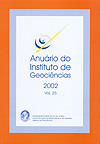Norito e charnoenderbitos da borda do maciço intrusivo de Venda Nova, Espírito Santo
DOI:
https://doi.org/10.11137/2002_0_99-124Resumo
O maciço intrusivo de Venda Nova, sul do Espírito Santo, possui estrutura inversamente zonada com gabros no centro e sienomonzonitos na borda. Estas rochas estão envolvidas por um anel estreito e irregular de norito e charnoenderbitos com estrutura quase isotrópica, com foliação apenas localmente desenvolvida. O norito é uma rocha cumulática fina com textura granular hipidiomórfica a intergranular. Os charnoenderbitos têm granulometria média e compreendem enderbitos, Opx-quartzodioritos e Opxgranodioritos leucocráticos a mesocráticos com textura granular hipidiomórfica a inequigranular porfirítica. As rochas possuem orto e clinopiroxênios e são observadas texturas subsolidus. A química de rocha total separa duas seqüências distintas, uma associada ao norito, básica com afinidade toleítica, e uma intermediária de assinatura cálcio-alcalina médio K relacionada aos charnoenderbitos. As características geoquímicas das rochas do bordo do pluton de Venda Nova diferem das rochas de afinidade alcalina do domínio interno. Ambas as seqüências do bordo mostram características geoquímicas similares: são metaluminosas, enriquecidas em Ca, Fe e Al e possuem moderados a baixos valores de elementos incompatíveis. Um protolito mantélico, de característica normal a ligeiramente depletado é aqui inferido para as duas seqüências.Downloads
Não há dados estatísticos.
Downloads
Publicado
2002-01-01
Como Citar
Mendes, J. C., Wiedemann, C. M. e McReath, I. (2002) “Norito e charnoenderbitos da borda do maciço intrusivo de Venda Nova, Espírito Santo”, Anuário do Instituto de Geociências. Rio de Janeiro, BR, 25, p. 99–124. doi: 10.11137/2002_0_99-124.
Edição
Seção
Artigos
Licença
Os artigos publicados nesta revista se encontram sob a llicença Creative Commons — Atribuição 4.0 Internacional — CC BY 4.0, que permite o uso, distribuição e reprodução em qualquer meio, contanto que o trabalho original seja devidamente citado.
















 Exceto onde indicado de outra forma, o conteúdo deste site é licenciado sob uma licença
Exceto onde indicado de outra forma, o conteúdo deste site é licenciado sob uma licença 